Related Research Articles

Welwitschia is a monotypic gymnosperm genus, comprising solely the distinctive Welwitschia mirabilis, endemic to the Namib desert within Namibia and Angola. The plant is commonly known simply as welwitschia in English, but the name tree tumbo is also used. It is called kharos or khurub in Nama, tweeblaarkanniedood in Afrikaans, nyanka in Damara, and onyanga in Herero. Welwitschia is the only living genus of the family Welwitschiaceae and order Welwitschiales in the division Gnetophyta, which contains three genera altogether. Informal sources commonly refer to the plant as a "living fossil".
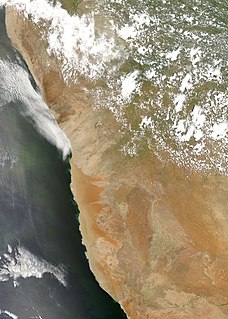
The Namib is a coastal desert in southern Africa. The name Namib is of Khoekhoegowab origin and means "vast place". According to the broadest definition, the Namib stretches for more than 2,000 kilometres (1,200 mi) along the Atlantic coasts of Angola, Namibia, and South Africa, extending southward from the Carunjamba River in Angola, through Namibia and to the Olifants River in Western Cape, South Africa. The Namib's northernmost portion, which extends 450 kilometres (280 mi) from the Angola-Namibia border, is known as Moçâmedes Desert, while its southern portion approaches the neighboring Kalahari Desert. From the Atlantic coast eastward, the Namib gradually ascends in elevation, reaching up to 200 kilometres (120 mi) inland to the foot of the Great Escarpment. Annual precipitation ranges from 2 millimetres (0.079 in) in the most arid regions to 200 millimetres (7.9 in) at the escarpment, making the Namib the only true desert in southern Africa. Having endured arid or semi-arid conditions for roughly 55–80 million years, the Namib may be the oldest desert in the world and contains some of the world's driest regions, with only western South America's Atacama Desert to challenge it for age and aridity benchmarks.
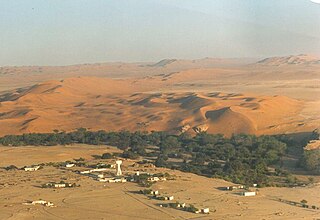
The Gobabeb Namib Research Institute is an internationally recognised centre for dry land training and research in Namibia. It is located in the Namib Desert, 120 km south-east of Walvis Bay.

Acanthosicyos horridus is an unusual melon that is endemic to the Namib desert. In English it is known as Nara, butter-nuts, or butterpips; in one of the Khoisan languages it is locally called ǃnaras or ǃnara.
The Namib brush-tailed gerbil or Setzer's hairy-footed gerbil is a species of rodent endemic to Angola and Namibia. Its natural habitats are sandy and gravelly plains. It stays in its burrow by day, emerging at night to feed on arthropods, vegetable matter, and seeds.
The dune hairy-footed gerbil, or the Namib dune gerbil is a species of rodent found only in Namibia. Its natural habitat is temperate desert where it lives in loose sand among sand dunes, feeding opportunistically on arthropods, seeds and green vegetation.

The rufous-eared warbler is a species of bird in the family Cisticolidae. It is found in Botswana, Namibia, and South Africa. It is the only species in the genus Malcorus. Its natural habitats are subtropical or tropical dry shrubland and subtropical or tropical dry lowland grassland.

Deadvlei is a white clay pan located near the more famous salt pan of Sossusvlei, inside the Namib-Naukluft Park in Namibia. Also written DeadVlei or Dead Vlei, its name means "dead marsh". The pan also is referred to as "Dooie Vlei" which is the fully Afrikaans name. There are many references to the site on the Internet, its name often being translated erroneously in terms such as "dead valley"; a vlei is not a valley. Nor is the site a valley; the pan is a desiccated vlei.
The Namibia Cricket Board, known commercially as Cricket Namibia, is the official governing body of the sport of cricket in Namibia. Its current headquarters is in Windhoek, Namibia. Cricket Namibia is Namibia's representative at the International Cricket Council and has been an Associate Member of that body since 1992. It is also a Member of the African Cricket Association.

Acanthoplus discoidalis is a species in the Bradyporinae, a subfamily of the katydid family (Tettigoniidae). Like its closest relatives, Acanthoplus discoidalis variously bears common names such as armoured katydid, armoured ground cricket, armoured bush cricket, corn cricket, setotojane and koringkriek. The species is native to parts of Angola, Namibia, Botswana, Zimbabwe and South Africa.
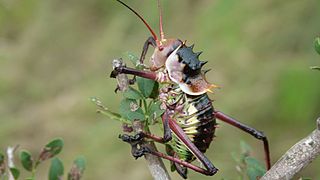
Acanthoplus is a genus of armoured ground cricket.
Trans Namib Ground is a cricket ground in Windhoek, Namibia. The first recorded match on the ground was in 1998 when a Windhoek Select XI played Denmark.
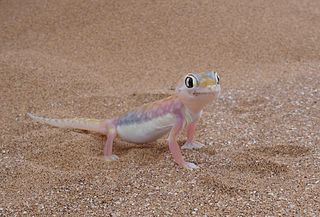
Pachydactylus rangei, the Namib sand gecko or Namib web-footed gecko, is a species of small lizard in the family Gekkonidae. It inhabits the arid areas of Angola, Namibia, and South Africa, and was first described in 1908 by Swedish zoologist Lars Gabriel Andersson, who named it after its finder, German geologist Dr. Paul Range.
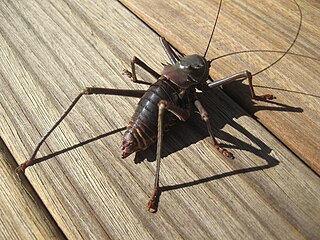
The long-legged armoured katydid is a species of katydid found in Namibia, and also in the northern portion of Northern Cape Province, South Africa, and southern Angola. It may possibly occur in Botswana. It is found in semi-arid and arid habitats, including the Kalahari Desert and the Namib Desert. It is threatened by habitat destruction, but is widespread and is not considered to be endangered.

Acanthoproctus is a genus of katydids.

The antlered thorny katydid is a species of katydid that is found in South Africa and Namibia. It can be found in semi-arid and arid habitats, including the Kalahari Desert, the Namib Desert, and in the Karoo and Fynbos biomes.

Bradfield's Namib day gecko is a species of lizard in the family Gekkonidae. The species is endemic to Namibia. This species was first described in 1935 by the British-born, South African zoologist John Hewitt, who gave it the name Rhoptropus bradfieldi in honour of the South African naturalist and collector R.D. Bradfield.
Pedioplanis husabensis, also known commonly as the Husab sand lizard, is a species of lizard in the family Lacertidae. The species is endemic to Namibia.
The Zimbabwe women's cricket team toured Namibia in January 2019 to play a five-match Women's Twenty20 International (WT20I) series known as the Namib Desert Challenge. These were the first matches with WT20I status to be played by Zimbabwe after the International Cricket Council announced that all matches played between women's teams of Associate Members after 1 July 2018 would have full T20I status. The venue for all of the matches was the Sparta Cricket Club Ground in Walvis Bay. Zimbabwe won the series 5–0.
References
- 1 2 Conti, E.; Viglianisi, F.M. (2005). "Ecology of the calling song of two Namibian armoured ground crickets, Acanthoplus longipes and Acanthoproctus diadematus (Orthoptera Tettigoniidae Hetrodinae)". Ethology Ecology & Evolution. 17: 261–269. doi:10.1080/08927014.2005.9522596. Archived from the original on 2011-07-22. Retrieved 2010-10-10.